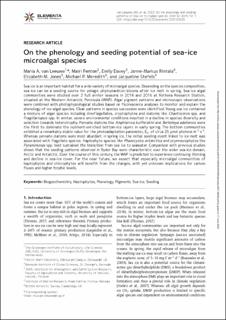| dc.contributor.author | van Leeuwe, Maria A. | |
| dc.contributor.author | Fenton, Mairi | |
| dc.contributor.author | Davey, Emily | |
| dc.contributor.author | Rintala, Janne-Markus | |
| dc.contributor.author | Jones, Elizabeth Marie | |
| dc.contributor.author | Meredith, Michael P. | |
| dc.contributor.author | Stefels, Jacqueline | |
| dc.date.accessioned | 2022-06-21T07:49:10Z | |
| dc.date.available | 2022-06-21T07:49:10Z | |
| dc.date.created | 2022-04-09T14:30:53Z | |
| dc.date.issued | 2022 | |
| dc.identifier.citation | Elementa: Science of the Anthropocene. 2022, 10 (1), . | en_US |
| dc.identifier.issn | 2325-1026 | |
| dc.identifier.uri | https://hdl.handle.net/11250/2999726 | |
| dc.description.abstract | Sea ice is an important habitat for a wide variety of microalgal species. Depending on the species composition, sea ice can be a seeding source for pelagic phytoplankton blooms after ice melt in spring. Sea-ice algal communities were studied over 2 full winter seasons in 2014 and 2016 at Rothera Research Station, situated at the Western Antarctic Peninsula (WAP). Algal pigment patterns and microscopic observations were combined with photophysiological studies based on fluorescence analyses to monitor and explain the phenology of ice-algal species. Clear patterns in species succession were identified. Young sea ice contained a mixture of algal species including dinoflagellates, cryptophytes and diatoms like Chaetoceros spp. and Fragillariopsis spp. In winter, severe environmental conditions resulted in a decline in species diversity and selection towards heterotrophy. Pennate diatoms like Amphiprora kufferathii and Berkeleya adeliensis were the first to dominate the nutrient-enriched bottom-ice layers in early spring. The bottom communities exhibited a remarkably stable value for the photoadaptation parameter, Ek, of circa 25 µmol photons m–2 s–1. Whereas pennate diatoms were most abundant in spring ice, the initial seeding event linked to ice melt was associated with flagellate species. Haptophyte species like Phaeocystis antarctica and prymnesiophytes like Pyramimonas spp. best sustained the transition from sea ice to seawater. Comparison with previous studies shows that the seeding patterns observed in Ryder Bay were characteristic over the wider sea-ice domain, Arctic and Antarctic. Over the course of this century, the WAP is predicted to experience continuing thinning and decline in sea-ice cover. For the near future, we expect that especially microalgal communities of haptophytes and chlorophytes will benefit from the changes, with yet unknown implications for carbon fluxes and higher trophic levels. | en_US |
| dc.language.iso | eng | en_US |
| dc.title | On the phenology and seeding potential of sea-ice microalgal species | en_US |
| dc.title.alternative | On the phenology and seeding potential of sea-ice microalgal species | en_US |
| dc.type | Peer reviewed | en_US |
| dc.type | Journal article | en_US |
| dc.description.version | publishedVersion | en_US |
| dc.source.pagenumber | 0 | en_US |
| dc.source.volume | 10 | en_US |
| dc.source.journal | Elementa: Science of the Anthropocene | en_US |
| dc.source.issue | 1 | en_US |
| dc.identifier.doi | 10.1525/elementa.2021.00029 | |
| dc.identifier.cristin | 2016361 | |
| cristin.ispublished | true | |
| cristin.fulltext | original | |
| cristin.qualitycode | 1 | |
